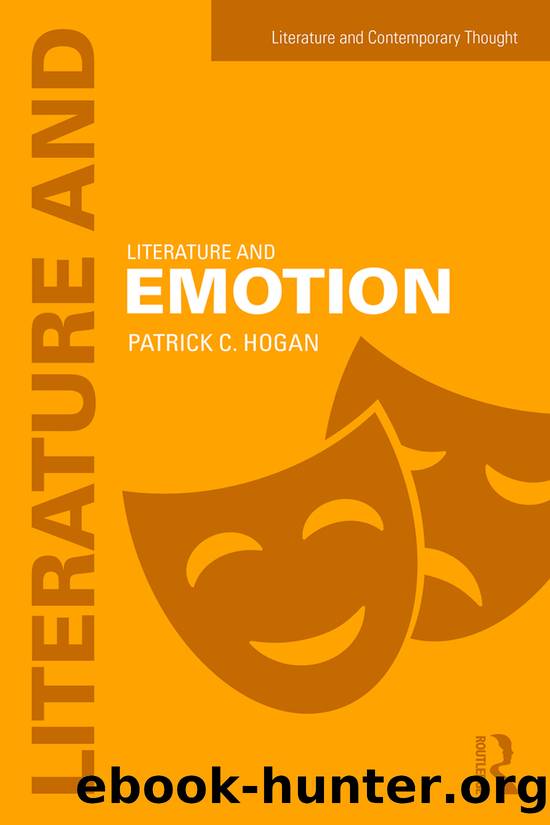Literature and Emotion by Patrick Colm Hogan

Author:Patrick Colm Hogan
Language: eng
Format: epub
ISBN: 9781317289593
Publisher: Taylor & Francis (CAM)
Mirth
Countless ordinary emotions make an appearance in our response to literature: fear, anger, jealousy, spite, indeed every emotion one can recall or imagine. Like aesthetic delight, however, mirth seems to have a special place in literature. We all often read literary works, watch movies or television, or go to plays in order to have a good laugh. Of course, we laugh at ordinary events and at witty conversation. But literature intensifies such mirth, often greatly. Mirth is, therefore, a particularly appropriate topic for the treatment of literary emotion.
There is a great deal of work on mirth or humor. To my mind, a particularly compelling cognitive and affective scientific account of the topic may be found in the work of Noël Carroll, a prominent philosopher of art and film theorist. Carroll’s discussion has the further advantage of systematically outlining and interrelating earlier influential accounts of humor. I will therefore focus on Carroll’s work in the way I focused on Plantinga’s work in treating emotion kinds.
Carroll begins his discussion with some terminological notes and a clarification of just what topic he is examining. Rephrasing Carroll’s point slightly, we might say that he is addressing a specific sub-type of the emotion of mirth, what he calls, “comic amusement.” The circumstantial eliciting conditions that foster comic amusement constitute “humor.” Carroll’s focus is therefore on humor, since he is concerned with defining and explaining those circumstantial elicitors. Carroll stresses that he is not explaining laughter (16) but comic amusement and humor.1 In our terms, laughter is a frequent expressive outcome of comic amusement and thus a good indicator of its presence. However, one may laugh without mirth and one may be amused without laughing. Thus an explanation of laughter would cover both too much (including some mirthless response) and too little (excluding some mirth).
Carroll then turns to theories of humor. Though he is precise and rigorous in his treatment of these theories, he groups together types of theory that should probably be distinguished. Specifically, full theories of humor strive to achieve both descriptive and explanatory adequacy. However, they may do this by different means. Put very roughly, one broad division is between theories that begin with description and theories that begin with explanation. More precisely, theories of humor generally set out to specify what sorts of things constitute elicitors of mirth. Most theories do this by setting out criteria for such elicitors, usually necessary and sufficient conditions for humor. Most theorists go on to seek some function for humor, as specified by these criteria. For example, Carroll argues in favor of a description of humor as crucially involving a sort of unthreatening incongruity (e.g., a clown wearing extra-large shoes). He goes on to give a functional explanation of humor in terms of the inculcation of social norms (e.g., a norm for fit in clothing).
Some theories, however, proceed in the opposite direction. Of course, all theories have a basic descriptive sense of the diverse phenomena that constitute humor. However, while most theories try to organize that diversity into some descriptive regularity, others rely solely on functional regularity.
Download
This site does not store any files on its server. We only index and link to content provided by other sites. Please contact the content providers to delete copyright contents if any and email us, we'll remove relevant links or contents immediately.
| Ancient & Classical | Arthurian Romance |
| Beat Generation | Feminist |
| Gothic & Romantic | LGBT |
| Medieval | Modern |
| Modernism | Postmodernism |
| Renaissance | Shakespeare |
| Surrealism | Victorian |
4 3 2 1: A Novel by Paul Auster(11035)
The handmaid's tale by Margaret Atwood(6838)
Giovanni's Room by James Baldwin(5873)
Big Magic: Creative Living Beyond Fear by Elizabeth Gilbert(4719)
Asking the Right Questions: A Guide to Critical Thinking by M. Neil Browne & Stuart M. Keeley(4567)
On Writing A Memoir of the Craft by Stephen King(4206)
Ego Is the Enemy by Ryan Holiday(3982)
Ken Follett - World without end by Ken Follett(3968)
The Body: A Guide for Occupants by Bill Bryson(3791)
Bluets by Maggie Nelson(3705)
Adulting by Kelly Williams Brown(3663)
Guilty Pleasures by Laurell K Hamilton(3578)
Eat That Frog! by Brian Tracy(3509)
White Noise - A Novel by Don DeLillo(3430)
The Poetry of Pablo Neruda by Pablo Neruda(3358)
Alive: The Story of the Andes Survivors by Piers Paul Read(3304)
The Bookshop by Penelope Fitzgerald(3222)
The Book of Joy by Dalai Lama(3212)
Fingerprints of the Gods by Graham Hancock(3207)
